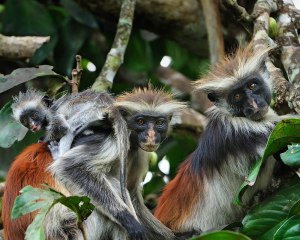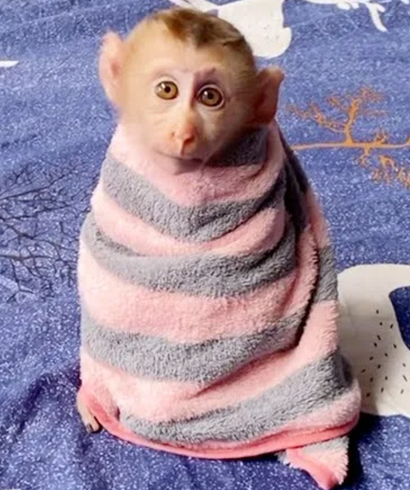
Colobus monkeys are a group of Old World monkeys belonging to two genera: Colobus and Piliocolobus. These primates are known for their striking black-and-white coloration, unique adaptations for a folivorous (leaf-eating) diet, and their presence in various African habitats. There are several species of colobus monkeys, each with distinct characteristics and behaviors.
General Characteristics
Colobus monkeys are medium-sized primates with a body length ranging from 45 to 70 centimeters (18 to 28 inches), and their tails are typically longer than their bodies, measuring up to 100 centimeters (39 inches).
Black-and-white colobus monkeys (Colobus genus) have a distinctive appearance with black fur and white facial markings, a white mantle of hair on their shoulders, and a long, white bushy tail.
Red colobus monkeys (Piliocolobus genus) have a more variable appearance, often with reddish or orange fur mixed with black or brown, and lack the white mantle and tail bushiness seen in black-and-white colobus monkeys.
Both genera have reduced or absent thumbs, which is an adaptation that allows them to more easily swing through trees.
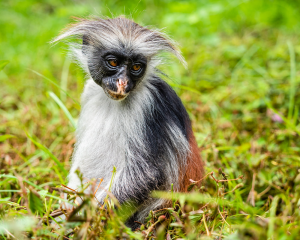
Behavior
Colobus monkeys are diurnal and arboreal, spending most of their lives in the trees. They are highly agile and can leap long distances between branches, using their long tails for balance.
They live in social groups, typically consisting of a single male and multiple females with their offspring, although some species form multi-male groups.
Colobus monkeys communicate using a variety of vocalizations, body postures, and facial expressions. These communications serve to maintain group cohesion, establish dominance, and alert others to potential threats.
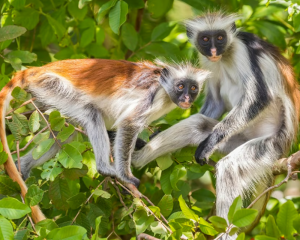
Habitat
Colobus monkeys are found throughout various parts of Africa, with different species adapted to different habitats. They typically inhabit forests, including primary and secondary rainforests, montane forests, and gallery forests along rivers.
Black-and-white colobus monkeys are found in a range of habitats, from coastal forests in West Africa to highland forests in East Africa.
Red colobus monkeys are primarily found in tropical rainforests and gallery forests across Central and East Africa, with some species adapted to more specific habitats like the swamp forests of the Congo Basin.
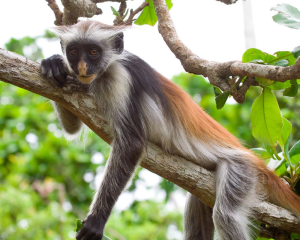
Diet
Colobus monkeys are primarily folivorous, meaning their diet mainly consists of leaves. They have a specialized stomach with multiple chambers, similar to that of ruminants, which helps them digest tough, fibrous plant material.
In addition to leaves, they also eat fruits, flowers, seeds, and occasionally bark or soil. However, leaves constitute the bulk of their diet.
Their complex stomachs allow them to ferment and extract nutrients from cellulose-rich leaves, which most other primates cannot efficiently digest.
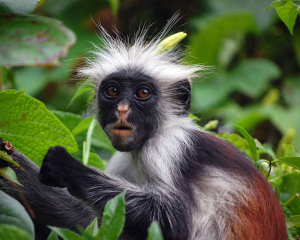
Social Structure and Behavior
Colobus monkeys typically live in small to medium-sized social groups. Black-and-white colobus groups usually consist of 3 to 15 individuals, while red colobus groups can be larger, sometimes exceeding 30 members.
The social structure of colobus groups can vary, with some groups being polygynous (one male with multiple females) and others having multiple males.
Female colobus monkeys tend to stay in their natal groups for life, while males may leave the group upon reaching maturity to avoid inbreeding and increase their chances of reproduction elsewhere.
Reproduction
Female colobus monkeys have a gestation period of approximately 5 to 6 months, and they usually give birth to a single offspring.
Infants are born with white fur, which gradually changes to the adult coloration over the first few months of life.
In many species, alloparenting (care of infants by individuals other than the mother) is common, with other group members helping to carry and protect the young.

Conservation Status
The conservation status of colobus monkeys varies by species, with some listed as “Least Concern” while others are “Endangered” or even “Critically Endangered.”
For example, the Angola colobus (Colobus angolensis) is listed as “Least Concern,” while the Tana River red colobus (Piliocolobus rufomitratus) is “Critically Endangered” due to habitat loss and fragmentation.
Threats
The main threats to colobus monkeys include habitat loss due to deforestation, agricultural expansion, logging, and human settlement.
Hunting for bushmeat and the illegal pet trade also pose significant threats to some colobus populations, especially in areas where food security is an issue or where traditional hunting practices are prevalent.
Additionally, some colobus species are affected by disease and competition with other primate species, further reducing their populations.
Conservation Efforts
Conservation efforts for colobus monkeys include habitat protection, anti-poaching measures, and the establishment of protected areas such as national parks and wildlife reserves.
There are also initiatives focused on community-based conservation, which aim to reduce human-wildlife conflicts and promote sustainable livelihoods for local communities.
Research and monitoring of colobus populations are crucial for understanding their ecology and behavior, which can help inform conservation strategies.
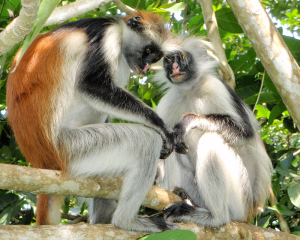
Unique Adaptations
Colobus monkeys have evolved a specialized digestive system to extract maximum nutrients from leaves. Their multi-chambered stomachs ferment plant material, allowing them to digest cellulose and obtain more energy from a leaf-based diet.
Their reduced thumbs and elongated fingers are adaptations for a life in the trees, allowing them to quickly and efficiently move through the forest canopy.
Alloparent Care
In many colobus species, group members other than the mother, such as siblings or other females, often help care for infants. This behavior, known as alloparental care, can provide social and survival benefits for the group.
Role in Ecosystems
Colobus monkeys play a vital role in their ecosystems as seed dispersers and consumers of vegetation. By feeding on leaves and fruits, they help shape the structure and composition of forests and contribute to plant regeneration.
Cryptic Behavior
Despite their striking coloration, black-and-white colobus monkeys are surprisingly well camouflaged in the dappled light of the forest canopy. Their black-and-white coats help them blend into the contrasting shadows and sunlight filtering through the trees.
